(!) Since support from Microsoft will end on January 14 2020, Windows 7 user might not be able to use MISUMI website effectively. Please consider to update your system as ‘MISUMI Website system requirement’.
- Scheduled Maintenance Notice: This site will be unavailable due to scheduled maintenance from 8:00 to 20:30 19/5/2024. We apologize for the inconvenience.
- แจ้งวันหยุดทำการในเดือน พฤษภาคม 2567 | Notice holiday in May 2024 > คลิก
Lead Screws, Nuts(Shaft Shape:One End Stepped)
Lead screws and nuts are mechanical components used to convert rotational motion into linear motion. A lead screw resembles a threaded rod with a helical groove, while the nut is a component that engages with the threads of the lead screw. As the lead screw rotates, the nut moves along its length, translating the rotational motion into linear movement. These components find widespread use in various applications such as CNC machines, 3D printers, robotics, and positioning systems. They are available in different materials, thread profiles, and sizes to accommodate specific requirements for load capacity, speed, precision, and environmental conditions. Overall, lead screws and nuts are essential for facilitating precise and controlled linear motion in mechanical systems. To select lead screws and nuts from MISUMI, navigate our website, browse the relevant section, use filters to narrow options by size and material, compare products based on specifications, availability, and place your order.
Configure
Specification/Dimensions
-
Shaft Shape
-
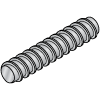 Straight
Straight -
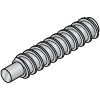 One End Stepped
One End Stepped -
 One End Double Stepped
One End Double Stepped -
 Both Ends Stepped
Both Ends Stepped -
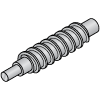 One End Stepped, One End Double Stepped
One End Stepped, One End Double Stepped -
 Both Ends Double Stepped
Both Ends Double Stepped
-
-
Nominal of Thread D(Ø)
-
Thread Position
- Right-Hand Thread
- Left-Hand Thread
- Right and Left-Hand Thread
- Precision Right and Left-Hand Thread
-
Thread Pitch(mm)
-
Shaft Material
- Steel
- Stainless Steel
-
Shaft Surface Treatment
- Not Provided
- Low Temperature Black Chrome Plating
- Black Oxide
-
Type
- Lead Screw
- Screw Nuts
-
Tolerance of Central Part (Incomplete Threaded Portion)
-
Screw Nut Shape
-
Screw Nut Material
-
Screw Nut Outer Dia. D(Ø)
-
Screw Nut Length L(mm)
Brand |
|
|---|---|
| CAD |
|
| Days to Ship |
|
- 2 items
- Sort By
-
You can add up to 6 items per a category to the compare list.
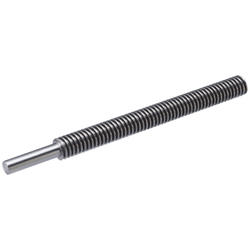
MISUMI
[Features]·30-degree trapezoidal lead screw that is used when there is no problem with a cantilever.Days to Ship: 5 Day(s)
5 Day(s)
-
Economy seriesYou can add up to 6 items per a category to the compare list.
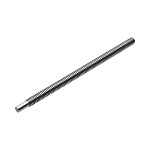
Lead Screws-One End Stepped Type
- Lead Screws-One End Stepped Type
- C-MTSRA, C-MTSTRA, C-MTSRB and C-MTSTRB are in MISUMI economy series.
- C-MTSRA and C-MTSTRA are Screw Turn Direction: Right-hand thread
- C-MTSRB and C-MTSTRB are Screw Turn Direction: Right-Hand Thread with Keyway
- Material of C-MTSRA and C-MTSRB: Equivalent to S45C
- Material of C-MTSTRA and C-MTSTRB: Equivalent to SUS303
- Thread Nominal Dia.: 8, 10, 12, 14, 16, 20, 22 and 25 mm.
- Shaft Overall Length L: 50-1200 mm.
- Thead pitch: 1.5, 2, 3 ,4 and 5Days to Ship: 12 Day(s)
12 Day(s)
| Brand |
|---|
| Product Series |
| CAD |
| From |
| Days to Ship |
| Shaft Shape |
| Nominal of Thread D(Ø) |
| Thread Position |
| Thread Pitch(mm) |
| Shaft Material |
| Shaft Surface Treatment |
| Type |
| Tolerance of Central Part (Incomplete Threaded Portion) |
| Screw Nut Shape |
| Screw Nut Material |
| Screw Nut Outer Dia. D(Ø) |
| Screw Nut Length L(mm) |
You can add up to 6 items per a category to the compare list. | You can add up to 6 items per a category to the compare list. | |
| Brand | MISUMI | |
| Product Series | ||
| CAD |
| |
| From | ||
| Days to Ship | 5 Day(s) | 12 Day(s) |
| Shaft Shape | One End Stepped | One End Stepped |
| Nominal of Thread D(Ø) | 8 ~ 50 | 8 ~ 25 |
| Thread Position | Right-Hand Thread | Right-Hand Thread |
| Thread Pitch(mm) | 1.5 ~ 8 | 1.5 ~ 5 |
| Shaft Material | Steel / Stainless Steel | Steel / Stainless Steel |
| Shaft Surface Treatment | Not Provided / Low Temperature Black Chrome Plating / Black Oxide | Not Provided |
| Type | Lead Screw | Lead Screw |
| Tolerance of Central Part (Incomplete Threaded Portion) | - | - |
| Screw Nut Shape | - | - |
| Screw Nut Material | - | - |
| Screw Nut Outer Dia. D(Ø) | - | - |
| Screw Nut Length L(mm) | - | - |
Loading...
Application example related to this category
Related Categories to Lead Screws, Nuts
FAQ Lead Screws, Nuts
- Question: How do lead screws and ball screws differ in their applications and efficiency?
- Answer: Lead screws and ball screws differ in their applications and efficiency due to design variations. Lead screws, using a threaded shaft and nut, suit low-speed, low-precision tasks like manual adjustments. They typically exhibit lower efficiency due to higher friction. In contrast, ball screws integrate ball bearings between the screw and nut, enhancing efficiency, precision, and speed. Consequently, ball screws find favor in high-precision, high-speed applications such as CNC machining, robotics, and aerospace systems where smooth, precise motion is critical, offering superior performance compared to lead screws.
- Question: What should be considered when choosing the size of a lead screw for a specific application?
- Answer: When choosing a lead screw size for an application, consider factors like load capacity, speed, and precision requirements. Determine the necessary length, pitch, and lead based on travel distance and desired linear speed. Ensure proper end support and mounting arrangements to prevent instability. Also, consider environmental conditions, material choice, coating, and acceptable backlash levels. By carefully weighing these aspects, you can select the appropriate lead screw size to ensure optimal performance and reliability for your specific application.
- Question: What are the advantages of using a 30-degree trapezoidal lead screw with a double-end step?
- Answer: Using a 30-degree trapezoidal lead screw with a double-end step offers numerous benefits. These include enhanced load capacity, improved stability, reduced backlash for precise positioning, increased efficiency due to smoother operation, and versatility allowing for flexible design options utilizing both ends. Overall, this configuration provides strength, stability, precision, and adaptability, making it ideal for a wide range of industrial and mechanical applications requiring reliable and precise linear motion.
- Question: What distinguishes MiSUMi C-VALUE Lead Screws from standard MiSUMi products in terms of cost and quality?
- Answer: MiSUMi's C-VALUE Lead Screws offer a balance between cost-effectiveness and quality. They are priced lower than standard MiSUMi products, making them more affordable for applications where precision requirements are less stringent. While C-VALUE Lead Screws maintain a level of quality suitable for many applications, they may not offer the same level of precision and performance as standard products. This means they might have slightly looser tolerances or undergo less rigorous testing. However, they still provide a cost-effective solution for applications where moderate precision is acceptable.
- Question: What factors should be considered when selecting a lead screw for high-load applications?
- Answer: When selecting a lead screw for high-load applications, factors such as load capacity, material strength, diameter, pitch, nut design, and lubrication must be considered. The lead screw should withstand the anticipated load without deformation, requiring a material with high tensile strength and a robust nut design. A larger diameter and coarser pitch help distribute the load effectively, minimizing deflection. Proper lubrication reduces friction and wear, prolonging the lead screw's lifespan under high-load conditions, ensuring reliable performance in demanding applications.






















How can we improve?
How can we improve?